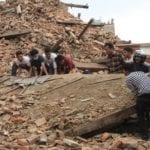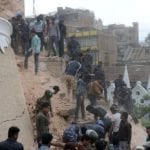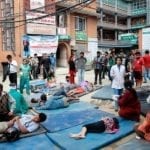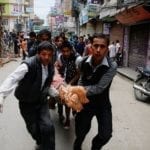
Photo Source: EPA
By Samantha Chan
On April 25, 2015, a 7.9-magnitude earthquake hit 48 kilometers north of Kathmandu, the capital city of Nepal. The reverberations were felt across the country. 9,000 people perished in the disaster and over half a million homes were destroyed. In response, the world pledged $4.4 billion in aid. And yet three years later, only 16% of this aid has been dispersed, fewer than 10% of 500,000 identified homes have been rebuilt, and many still live in temporary shelters. The case of Nepal highlights stark fundamental challenges facing international philanthropy and disaster response.
The Global Response
Although aid poured in from countries all over the world, there was no clear path for these donations to be channeled in the rebuilding effort. Bureaucracy, regulations, and miscommunication between local, national, and governing bodies contributed to long delays in reconstruction. This lack of coordination is a frequent occurrence when managing aid in the immediate aftermath of a disaster.
Immediately after the earthquake, the Nepali government and political authorities created the National Reconstruction Authority to oversee relief and rebuilding efforts, but it took months for a leader to be appointed. Meanwhile, local governments that hadn’t held elections in the previous 16 years left communities without a strong sense of democratic representation. This made organizing resources and supervising reconstruction projects very difficult for the National Reconstruction Authority to manage in local communities.
At the international level, geopolitical tensions further slowed the process of bringing foreign aid to Nepal. Nepal is a landlocked country, sharing borders with China and India. At Nepal’s southern border with India, an alleged blockade prevented supplies from reaching in Nepal. Ethnic tensions between Indian and Nepali tribes along the southern border were blamed for the delayed transport of much needed resources to Nepal. China provided free oil during this blockade, but roads along the China-Nepal border were in such poor condition that the oil could not reach its intended locations. China and India are often competing for influence in the Asian subcontinent and the international response to the earthquake only exacerbated tensions between China, India, and Nepal.
Frustrated by the lack of progress, many donors turned to various NGOs to bypass the bureaucracy of the national government. Although well intentioned, a lack of a coordinated effort between these NGOs prevented aid from reaching communities affected by the earthquake. Over 300 NGOs were reported to be working in the Ghorka district alone. Many people were still in need of food and shelter but the only received relief from international NGOs (INGO) in the form of Bibles, Qurans, or unusable helicopters. Critics attributed this misalignment by INGOs to a lack of coordination with local communities which prevented the mobilization of relief efforts.
The humanitarian response in Nepal following the 2015 earthquake highlights the need for grassroots-level work in disaster preparedness and relief efforts. Located in the heart of the Himalayan mountain range, Nepal remains vulnerable to high seismic-risk. Local knowledge is needed to strengthen the effectiveness response efforts and ensure they meet the needs of at-risk communities. This requires preparation for the short- and long-term needs of local communities.
Give2Asia’s Disaster Response
Give2Asia raised over $3 million USD for response programming to the earthquake. Access to its local network enabled Give2Asia to identify specific organizations that would be effective at the local level, including groups that could coordinate preparedness trainings and the rebuilding of homes and schools. Give2Asia grants reached underserved areas including the Ghorka, Sindhupowlchuk and Dolakha districts.
Within these districts, Give2Asia funded projects that addressed the short-term and long-term needs of disaster relief and risk-reduction. Short-term projects included building transitional shelters and toilets and restoring electrical power supply. Mid- to long-term projects included rebuilding damaged homes, schools, and overall infrastructure to increase their ability to withstand future earthquakes or other disasters. Further, projects operated by Koshish Nepal continue to provide psychosocial services for impacted persons who now suffer from related mental health issues. While donations tend to wane six months after a disaster has struck, it is precisely this long-term programming that provides the critical support needed to build community resilience.
The case of Nepal demonstrates the great challenges facing countries impacted by disasters, and offers a model that prioritizes long-term recovery and preparedness so that every philanthropic dollar goes further. Give2Asia’s model of disaster resilience programming at the local level creates pathways for donors to maximize their impact both before and after a disaster strikes.
To date, Give2Asia has swiftly and thoughtfully responded to over 40 natural disasters in Asia and rebuilt local communities with $50 million in funding. For more information, contact Sheena Agarwal: sagarwal@give2asia.org.
This post is part of a month-long spotlight on disaster resilience.
Learn more and explore the other programming from this feature on the disaster resilience resource page.









